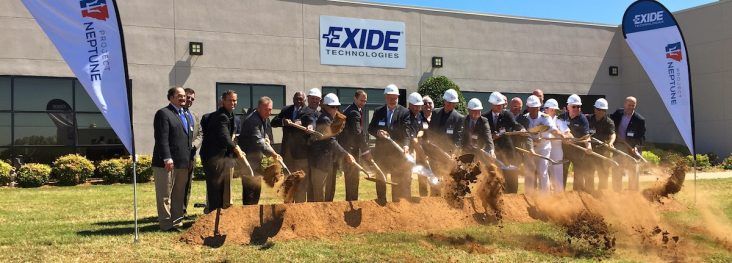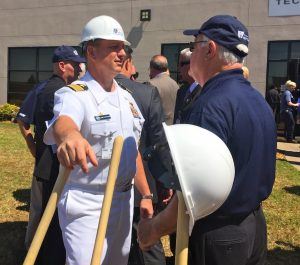Exide’s Fort Smith plant to get $30.7 million grant to aid production of batteries used in nuclear subs (Updated)
by June 28, 2016 9:11 am 1,005 views

Dignitaries toss dirt for the ceremonial groundbreaking at Exide’s Fort Smith battery manufacturing plant. Exide Technologies has received a $30.7 million “cost-sharing” grant from the federal government to upgrade the plant.
Editor’s note: Story updated with many additions and changes throughout.
––––––––––––––––––
Exide Technologies has received a $30.7 million “cost-sharing” grant from the federal government to upgrade its Fort Smith battery manufacturing plant as part of a program to improve battery systems used on U.S. Navy nuclear submarines.
The announcement held Tuesday morning (June 28) at Exide’s Fort Smith plant, with U.S. Rep. Steve Womack, R-Rogers, joined by Exide President and CEO Vic Koelsch, Arkansas Lt. Gov. Tim Griffin (R), Fort Smith Mayor Sandy Sanders, Arkansas Economic Development Commission Executive Director Mike Preston, First National Bank President and CEO Sam Sicard representing the Fort Smith Regional Chamber of Commerce, and officials with the U.S. Navy.
The project will add 12,000 square feet to the 224,000-square-foot plant, and work is set to begin immediately and finish by August 2021. The grant work is referred to as “Project Neptune.” The grant, which became effective Jan. 25, is a five-year, cost-sharing agreement between the U.S. Government and Exide. The federal share is $18.7 million and Exide picks up the remaining $12 million.
Company officials estimate 5-7 new “high-skilled, high-paying jobs,” with the program. Exide employs 190 in Fort Smith, with 153 hourly and 37 salaried jobs. The plant was first opened in 1975 to produce backup batteries for AT&T and Bell Telephone. In addition to batteries used for the military, the Fort Smith plant also makes batteries used in wireless communication systems, railroad signaling, nuclear and other power-generation plants, and batteries for forklifts and other material handling equipment.
“I’m extremely proud of the incredible work the great folks at the Fort Smith facility are doing – it’s important to our Navy service men and women – and it’s important to our nation,” according to a statement from Womack. “In the event of main power failure on a submarine – a critical national security platform – backup power ultimately becomes the critical life-line to ensuring the safety of our brave sailors who put their lives on the line every day in defense of our nation.”
USE OF FUNDING
Funding falls under the “Defense Production Act Title III Program,” and is designed to advance production and process design of storage batteries. Exide’s Fort Smith plant – which in November 2015 celebrated its 40th year with the company – produces flooded and valve-regulated lead-acid (VRLA) batteries used in a numerous commercial applications and as the main storage emergency AC/DC backup power deployed on U.S. Navy nuclear submarines.
The main storage battery functions as emergency backup power for nuclear subs and is capable of supplying power for propulsion if necessary. Emergency backup power supports communications, lighting, controls, and life support systems.

“Funding will automate and improve the battery production process at Fort Smith, including enhancements to quality control, automated data collection systems, new equipment and improved process flow, creating a state-of-the-art battery manufacturing facility,” noted an Exide statement.
Enhancements are expected to be made plantwide.
“It is basically a restructuring of every major process in the plant,” Koelsch told the audience.
THE NASCAR ANALOGY
A common theme by those who spoke Tuesday was that Project Neptune will help Exide boost its overall battery business and is a first step toward securing more defense-related funding.
Koelsch, who grew up in Oklahoma and is a graduate of the U.S. Air Force Academy, said the $30.7 million project will help the company continue to rebound from its recent bankruptcy reorganization, saying “events like today mark significant turning points.” He also said Arkansas and local officials helped secure Project Neptune, and when the company faces future expansion and investment decisions, “we will remember the state of Arkansas.”
Capt. Scott Pappano, a Naval Academy graduate affiliated with the Navy’s submarine fleet since 1989, including serving as commanding officer of the USS Buffalo, compared Exide’s battery work for the Navy to that of Goodyear’s connection to NASCAR in terms of marketing and product testing. Not only is providing batteries to the Navy good for marketing, but the batteries are used in “the most grueling environment” with the Navy. Lessons learned from the Navy’s use of batteries helps Exide produce a better battery for commercial customers, Pappano said.
Pappano also said it is likely the batteries produced at Exide’s Fort Smith plant will be used in the planned USS Arkansas, a Virginia-class sub that Secretary of the Navy Ray Mabus recently said should join the fleet by 2023.
“We want to see that battery on the USS Arkansas in the future,” said Pappano, who now serves as the Strategic and Attack Submarine Program Manager.
Lt. Gov. Griffin said there is often “inertia to contracts” with defense departments, and said Project Neptune could be the start of such inertia for Exide’s Fort Smith plant.
“This is the beginning. This is the beginning of additional opportunity that will come to this company,” Griffin said.
Griffin also said Arkansas is getting a reputation for being a good place for defense industry work. He said the state’s “quality workforce” is a big part of the growth, and said elected officials need to do more to create an environment in which Arkansas will be even more attractive for defense-related work.
BANKRUPTCY HISTORY
The company in June 2013 filed for Chapter 11 bankruptcy reorganization. At the time, the company had 13 manufacturing operations in the U.S., including the Fort Smith plant located at the corner of Zero Street and Old Greenwood Road, and 74 branch operations which sell and distribute products. Exide has 3,600 U.S. employees, with 1,100 salaried and 2,500 hourly, including 540 union workers. The company then employed 231 in Fort Smith, with 193 hourly and 38 salaried.
In the filing, the company cited the loss of $160 million in annual revenue when Wal-Mart Stores shifted a contract from Exide to Johnson Controls.
Exide, then a publicly-held company trading over the counter under the ticker symbol XIDEQ, secured $500 million debtor-in-possession (DIP) financing through a group of financial institutions and investors in connection with the filing.
The company emerged from bankruptcy in early 2015 as a privately-held company. The company was able to write off $600 million in debt and secured $200 million in “exit financing” – working capital – from several large banks.
